How is Bladder Exstrophy diagnosed?
See how Bladder Exstrophy is diagnosed. Which specialists are essential to meet, what tests are needed and other useful information for the diagnosis of Bladder Exstrophy

How is Bladder Exstrophy Diagnosed?
Bladder exstrophy is a rare congenital condition where the bladder is located outside the body. It occurs due to a developmental defect during fetal development. Diagnosing bladder exstrophy involves a combination of physical examinations, medical imaging, and laboratory tests.
Physical Examination:
During a physical examination, a healthcare provider will carefully examine the newborn's lower abdomen and pelvis. They will look for visible signs of bladder exstrophy, such as an open bladder and exposed urethra. The healthcare provider will also assess the overall health of the newborn and check for any associated abnormalities.
Medical Imaging:
Medical imaging plays a crucial role in diagnosing bladder exstrophy. The following imaging techniques are commonly used:
- Ultrasound: An ultrasound uses sound waves to create images of the bladder and surrounding structures. It can help visualize the position and size of the bladder, as well as any associated abnormalities.
- X-ray: X-rays may be taken to assess the pelvic bones and spine for any abnormalities or malformations.
- Magnetic Resonance Imaging (MRI): An MRI provides detailed images of the bladder, pelvic bones, and surrounding organs. It can help evaluate the extent of the bladder exstrophy and identify any associated anomalies.
Laboratory Tests:
Laboratory tests are often performed to gather additional information and confirm the diagnosis. These may include:
- Urinalysis: A urine sample is analyzed to check for any urinary tract infections or abnormalities.
- Genetic Testing: In some cases, genetic testing may be recommended to identify any underlying genetic abnormalities or syndromes associated with bladder exstrophy.
Additional Evaluations:
Once the diagnosis of bladder exstrophy is confirmed, further evaluations may be necessary to assess the overall health and function of the urinary system. These evaluations may include:
- Cystoscopy: A cystoscopy involves inserting a thin tube with a camera into the bladder to visualize its internal structures. It helps assess the bladder's capacity, shape, and any associated abnormalities.
- Voiding Cystourethrogram (VCUG): A VCUG is a specialized X-ray procedure that evaluates the bladder and urethra during urination. It can help identify any reflux of urine or abnormalities in the urinary tract.
- Kidney Imaging: Imaging tests such as a renal ultrasound or renal scan may be performed to assess the health and function of the kidneys.
It is important to note that diagnosing bladder exstrophy requires a multidisciplinary approach involving pediatric urologists, radiologists, geneticists, and other healthcare professionals. The combination of physical examinations, medical imaging, laboratory tests, and additional evaluations helps ensure an accurate diagnosis and appropriate management of bladder exstrophy.
Posted Oct 11, 2017 by Giovanni 3050
Posted Jul 13, 2017 by Lorena 1850








